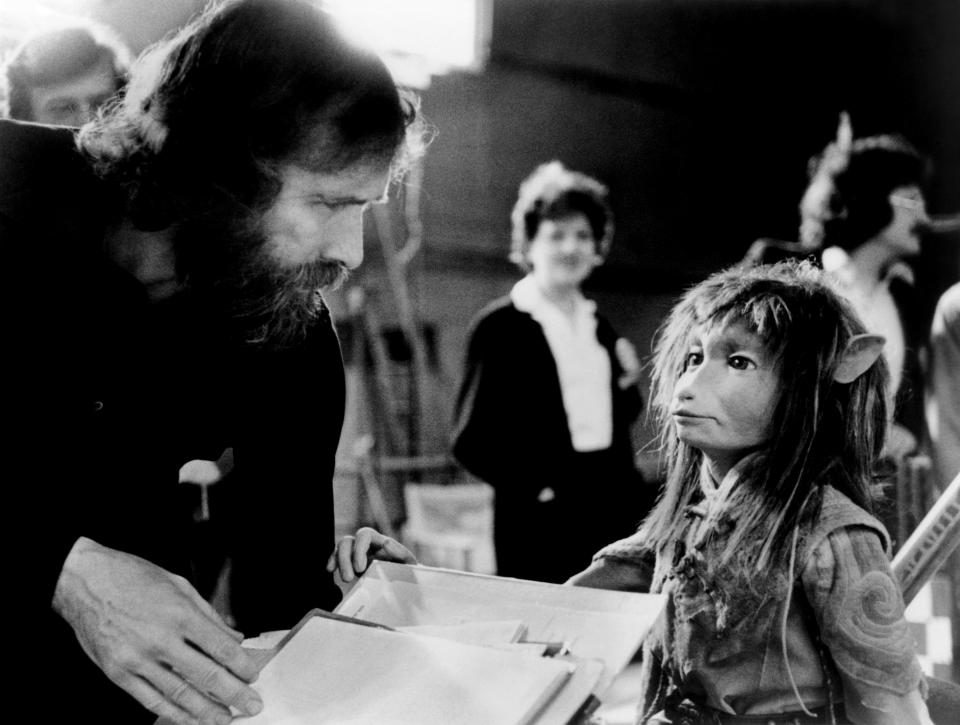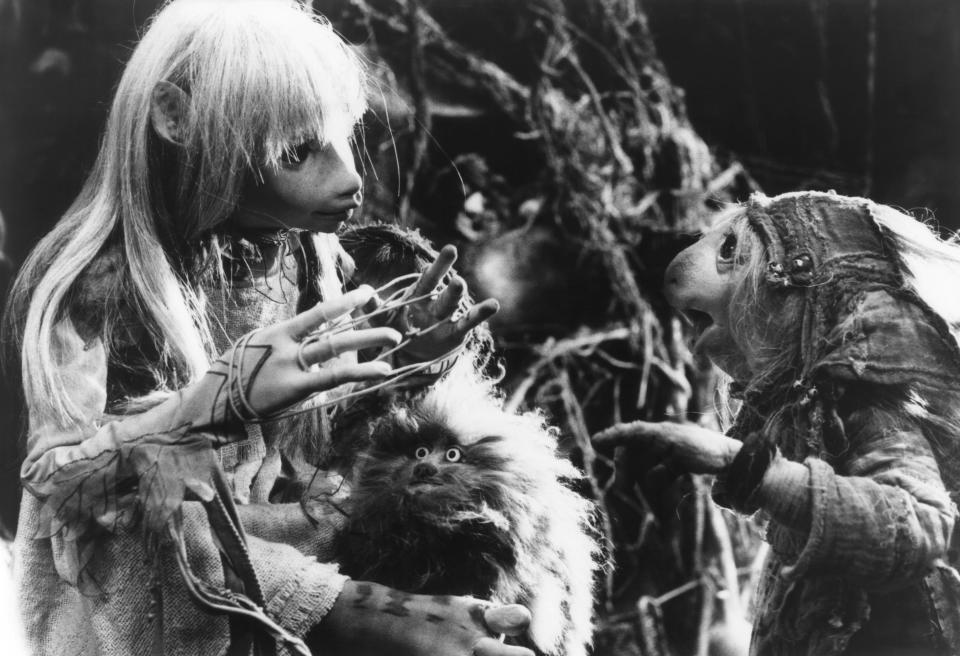Jim Henson's daughter on continuing her father's legacy with 'Dark Crystal' prequel series: 'This was the project that brought me closest to him'
Lisa Henson was in her early 20s when she first journeyed to Thra, the fantasy universe created by her father, Jim Henson, in the 1982 feature film, The Dark Crystal. The legendary puppeteer and entertainer transformed soundstages at England’s famed Elstree Studios into a living, breathing world, one populated by such lovingly crafted creatures as the diminutive, but heroic Gelflings and their towering, bird-like villains called Skeksis. His daughter worked as a production assistant on that film, and shared his company both on and off-set, taking long walks and sharing meals in their family home.
Because of that foundational experience in the industry, Henson has always had a personal connection to Thra, so it’s no surprise that she’s one of the driving creative forces behind the new prequel series, The Dark Crystal: Age of Resistance. Now streaming on Netflix, the 10-episode adventure turns back the clock to a time of relative peace — a peace that’s shattered when the Skeksis discover just how much the Gelflings can contribute to their own survival. Like the film, Age of Resistance was made in England, and Henson says that she followed the footsteps left by her younger self and her father — who died suddenly in 1990 — all those years ago. “I lived in my father’s house, which we’ve kept, took his walk along the heath and went to work making our Crystal,” she tells Yahoo Entertainment. “I’ve done many things in my professional life, but this was the project that brought me the closest to him in many years.”

We spoke with Henson about the challenges involved in making a new Dark Crystal, and why her father would be happy to know that a new generation of storytellers are putting their own stamp on Thra.
Yahoo Entertainment: How did you decide where exactly you wanted the story of Age of Resistance to begin?
Lisa Henson: We have a pretty developed franchise timeline for what’s happening in Thra — we actually put it online. We call this period the Gelfling Gathering, and what I love about it is that it's the period when the Gelflings discover for the first time the nature of the evil that the Skeksis possess. They learn that they’re being used by the Skeksis on both a material level, because they’re being taxed, but also an existential level because their essence is being drained. The idea is that they have to put aside the differences amongst themselves in order to take some action.
How much of that timeline was worked out by your father for the original film?
He had some of it in place, but we did a lot more world-building and brainstorming with a big group of people, including Brian Froud. [Froud served as a conceptual designer on both The Dark Crystal and Labyrinth.] So in terms of building out this prequel world, the most important piece of canon that we had was a big coffee table book The World of the Dark Crystal that Brian originally did after the film came out. It was really an art book, but he also worked with the writer [David Odell] and created a lot of mythology. In that book, he named every Skeksis and every Mystic, and explained where the UrSkeks came from and why and how the Mystics and the Skeksis split. So we used that book as our jumping off point, and then we went further. We also have a YA series of books that have been published for the last couple of years laying the groundwork for this part of The Dark Crystal timeline.

The movie wasn’t a huge hit when it came out, but it has lived on in the minds of those of us who grew up watching it. Did you set out to make something that would enjoy a broader success?
I try to remind people that it was Labyrinth that was the big financial disappointment. The Dark Crystal did pretty well and it did quite well internationally. And one of the things that really works about The Dark Crystal is its universal themes. It didn’t ever play as a foreign entertainment in other parts of the world, because the characters aren’t human and aren’t from anywhere specific. Netflix is going to drop Age of Resistance in every country at the same time, and it’s quite well-known around the world so that’s something we kept in mind throughout development. It’s not an American story, it’s a world story. We knew that people love the Gelflings and that there were only two of them in the film. Because they were the most aspirational characters, we really wanted to develop that civilization. You see the ruins of this beautiful, thriving civilization in the movie, so we decided that we wanted to go there — we wanted to see that world when it was brighter and more colorful, and not yet decayed and brown.
We also knew that the pacing of the original film is a little slow for today's audiences. So one of the first things we did was hire director Louis Leterrier, who actually came to us to talk about The Dark Crystal. And by having him involved, it enabled us to promise Netflix that the show would have a different kind of pacing. I mean this is the director of The Transporter and Clash of the Titans! I like to say that the original film is stately, but this is not going to be a stately approach. It’s young characters with a lot of energy and spirit.
Are there any puppets from the original film that make appearances here?
What happens to puppets that have foam is that the foam decays over time. We call them “toast,” because they just crumble. The original Skeksis have been restored and are on display in different museums, but they can’t be puppeteered anymore. So we rebuilt those characters and added more, because if you go back in the timeline, there would have been more Skeksis. That was probably the most fun for everybody; our writers are particular proud of The Heretic, who Andy Samberg plays, and The Collector, played by Awkwafina. We also had the chance to essentially create The Emperor from scratch, because he dies in the first scene of the movie. Jason Isaacs voices him, and is so amazing and powerful, while also being wildly scary at the same time.

Seeing Mark Hamill’s name in the credits is obviously thrilling for a person of my generation. Did he get to choose which Skeksis to play?
There are certain characters that had to have a voice match [because they appeared in the film], so we had him in mind for The Scientist. He and Simon Pegg, who plays the The Chamberlin, bring their acting brilliance to the roles, but they’re also copying the original voices. We weren’t planning on having a star in every role, but it just became a snowball as we were doing the casting process. I was very excited by that, even though it’s not exactly how most Henson projects are done. It reflected a new love of the tradition of what we do with puppetry, and we got the endorsement of having famous actors involved.
But, of course, it’s ultimately the puppeteers who are playing these characters! They don’t get seen, so we try to talk about them as much as possible. We had 12 main puppeteers who did all the main roles, just like my father always worked with what he called the core puppeteers. And then we had an army of assistant puppeteers, who did the radio controlling of the characters’ eyes or assisted with body performance. We cast all the puppeteers very carefully; we were looking for a certain quality of performance that's different from the comedy of the Muppets. It was a very challenging shoot, and Louis was on set everyday because he directed every episode. He operated a Steadicam, too! It was this fierce and exciting leadership that he exercised for the 10 months of shooting.
I’m sure you hope to tell more stories in the world of Thra: How did that impact where you chose to end this season?
When [showrunners] Jeffrey Addiss and Will Matthews pitched us their version of the series, it actually did continue on past this and then we realized it was moving too quickly and we cut it back. So even though we made 10 episodes, we only have produced six of their original episodes. We definitely have ideas about where it goes from here, but time will tell if we’ll be making a Season 2 or not.
Obviously, the story has to get darker as the timeline continues, since the Gelfling race is all but wiped out by the time the movie begins. Is the idea that kids who discover Age of Resistance will grow up with the series — sort of like the way the Harry Potter books grew more mature over time?
I hadn't thought about that, but it kind of does make sense. But I also can't say with assurance that it would get darker. We’d always find balance and I think part of what's so wonderful about this series is that the dark is balanced by the light, and there is a lot of humor and very sweet character development. So while it has its dark points, there’s also a lot of light to balance it out.

This question comes from my son, who is already a major continuity nerd: In the film, Kira calls her animal sidekick “Fizzgig.” But in the series, it’s revealed that “Fizzgig” is the name of an entire species. So does that mean she essentially named her dog “Dog”?
[Laughs] He’s right! Kira does call him Fizzgig. For the series, we decided that we wanted to call the species Fizzgigs because that’s how people know them. So in the show, they have actual names like Baffi. You know, my father once did a show called The StoryTeller, and that character has a dog named Dog, too. I guess that’s a good reference!
Do you think your father would be happy with how Age of Resistance builds upon what he started with The Dark Crystal?
I feel confident that he would like it and be really happy. And I think he'd feel happy that other people are doing it, because he really wanted his projects to be passed on to other people. He was thrilled when Frank Oz directed The Muppets Take Manhattan, because he could move on to other things. I was talking with [Muppeteer] Dave Geolz on set; he had worked on the film and then came on the show to puppeteer Baffi, and he was so flattering about the way we were making the series. He said that the spirit on set felt very true to the heyday of Jim and the Muppets.
The Dark Crystal: Age of Resistance is currently streaming on Netflix.
Read more from Yahoo Entertainment:
Want daily pop culture news delivered to your inbox? Sign up here for Yahoo Entertainment & Lifestyle’s newsletter.


